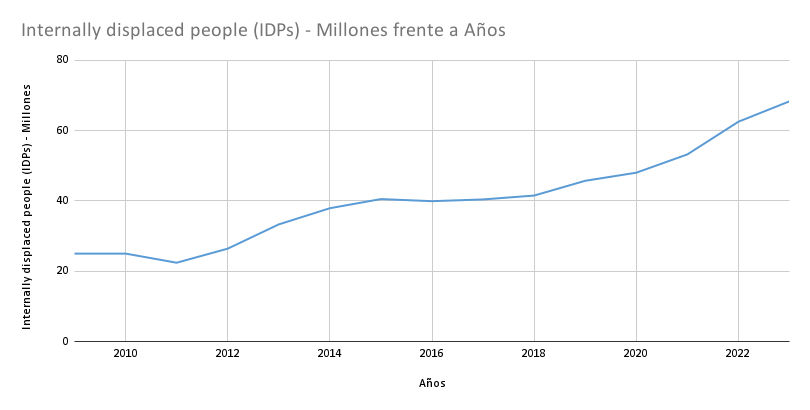Internal Displacement by Conflict and Violence

Internal displacement caused by armed conflict represents one of the most severe humanitarian crises of our time. According to the latest IDMC report, by the end of 2023, a historic record of 75.9 million internally displaced persons (IDPs) was reported across 116 countries and territories. Of this number, 68.3 million were due to conflict and violence, while 7.6 million were caused by natural disasters.
Explore the statistics of internal displacement due to conflict or violence in our database.
Who are the internally displaced people?
Internally displaced persons are those who have been forced to leave their homes but remain within their own country. This situation is characterized by involuntariness and confinement within national borders, placing millions of people in a position of particular vulnerability as they remain under the jurisdiction of states that lack sufficient tools, resources, and processes to ensure their well-being.
Why should we talk about internal displacement?
Recent statistics show that between 2022 and 2023, the number of displaced persons due to conflict and violence grew by 9%. This is a worrying trend in the long term, as in just five years, the total number of internally displaced people worldwide has increased by more than half (51%). These figures translate into interrupted lives, fragmented communities, abandoned productive activities, exclusion, and stigmatization.

The five countries that raise the alarm:
Sudan: 9.1 million internally displaced persons
Sudan, one of the 54 countries in Africa, is facing a devastating internal displacement crisis triggered by the conflict that erupted in April 2023. Millions are fleeing intense urban combat and intercommunal violence in border regions. The collapse of basic services, food insecurity, and blockades on humanitarian aid are additional factors that contribute to the extreme emergency conditions in the country.
Syria: 7.2 million internally displaced persons
After a decade of civil war since 2011, Syria continues to have one of the largest records of internal displacement in the world. 7.2 million people have been forced to leave their homes but remain within the country’s borders. Ongoing military operations, economic collapse, and massive infrastructure destruction have worsened the situation, leading to further displacement. Many Syrian families have been displaced multiple times, depleting their resources and facing increasingly precarious living conditions in makeshift camps or informal settlements, with limited access to basic services such as clean water, healthcare, and education.
Democratic Republic of the Congo: 6.7 million internally displaced persons
The Democratic Republic of the Congo is another African country continuing to face a complex displacement crisis with 6.7 million internally displaced persons, primarily driven by intensified fighting and intercommunal violence. The conflict has mainly been fueled by the struggle for control over valuable natural resources like gold, coltan, and diamonds. Many families experience repeated displacement under extremely precarious conditions, abandoning their livelihoods and facing severe protection risks that disproportionately affect women and children.
Colombia: 5.1 million internally displaced persons
Colombia is one of the South American countries facing rural displacement and a growing phenomenon of urban and intra-urban displacement. The 5.1 million internally displaced persons reflect the accumulated legacy of more than five decades of internal armed conflict that, despite the peace agreement signed with the FARC in 2016, continues to face significant obstacles such as threats against social leaders, the continued presence of armed groups in original territories, and situations of confinement where entire communities are trapped under the territorial control of dissident armed groups, the National Liberation Army (ELN), drug-trafficking organizations, and criminal gangs that fight over strategic territories like the Colombian Pacific and Bajo Cauca.
Yemen: 4.5 million internally displaced persons
Yemen, a bi-continental country that shares borders with Oman and Saudi Arabia, currently hosts 4.5 million internally displaced persons as a result of a devastating civil war. The conflict between Houthi rebels and the Saudi-led coalition has caused repeated and massive displacement of Yemeni families as frontlines shift. Constant bombings, ground combat, and a collapsed economy have left 80% of the population dependent on humanitarian aid. The impact of natural disasters such as floods and droughts has created a double vulnerability for populations already exhausted by years of conflict, with collapsed healthcare services and recurrent disease outbreaks like cholera. Blockades, restrictions on humanitarian access, and bureaucratic obstacles have dramatically worsened the situation for displaced people.
The Importance of Understanding Displacement
The cases highlighted here reflect the landscape of internal displacement caused by conflict and violence, representing a part of the global humanitarian crisis that continues to escalate daily. The 51% increase in global records over the last five years not only indicates the persistence of chronic conflicts but also the emergence of new crises that feed into the cycle.
One of the challenges in monitoring these situations is the difficulty of collecting data on displacement in conflict contexts, which tends to be scarce. A call for better data collection over time would help policymakers assess how the needs of displaced persons evolve and design more effective pathways toward durable solutions.